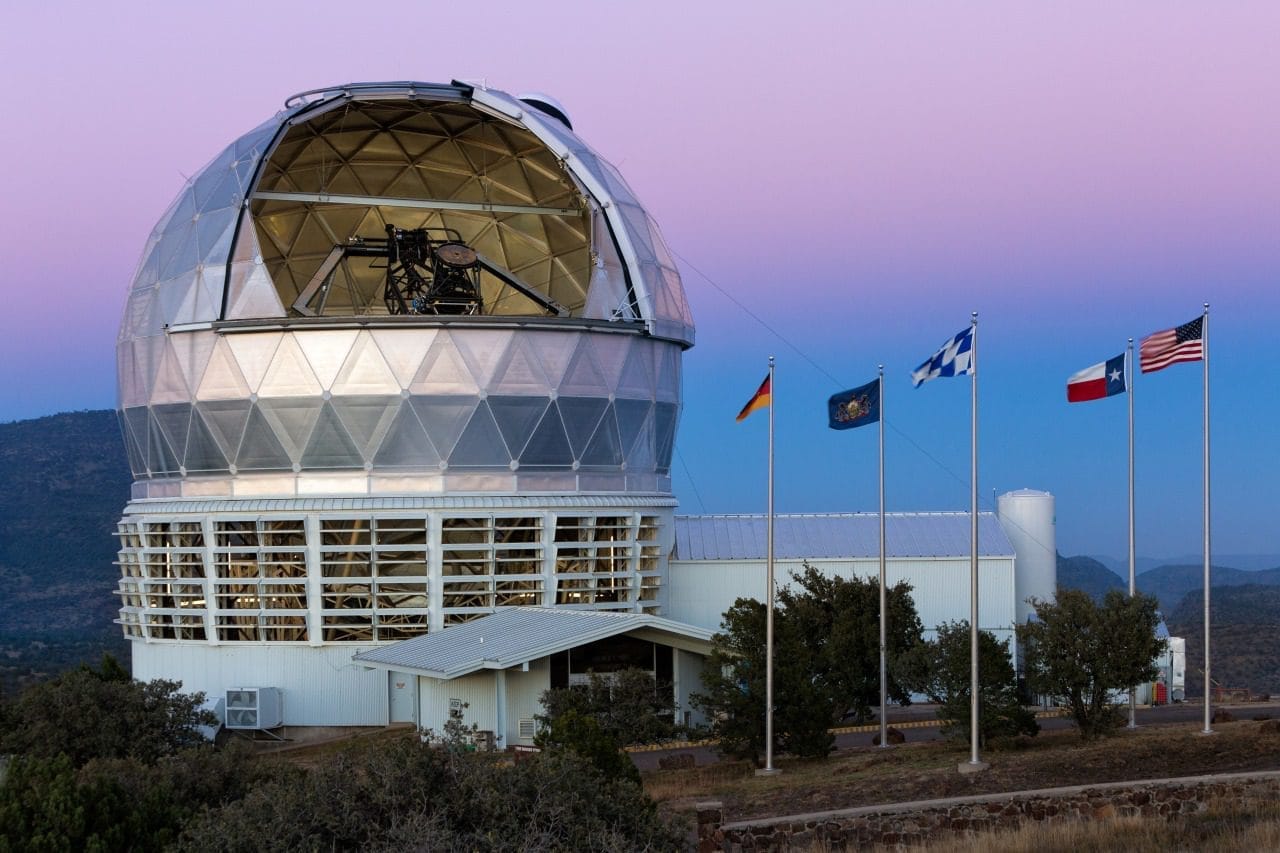Want to know what are the biggest telescopes on Earth in 2025? The largest telescopes in the world are often the most successful in making new space discoveries, because of their ability to gather more light and delve deeper into the history of the universe from impressive distances.
The biggest does not always equate to having the best telescope, and the overall light-gathering power of the optical system can be a poor measure of a telescope’s performance. Some of the largest telescopes on Earth are serving as Earth’s eyes to detect supernovae, galaxies, and other distant objects. Here are the top 10 biggest telescopes on Earth that are in operation today and in progress in 2025.
10. Hobby-Eberly Telescope (USA)

- Location: Texas, United States
- Telescope style: Optical, segmented mirror
- Diameter: ~10 meters
The 10-metre Hobby-Eberly Telescope (HET) remains one of the biggest telescopes on Earth in 2025 among operating optical observatories. Based at McDonald Observatory in Texas, it is optimized for spectroscopy – analyzing the light from stars and galaxies to study their composition, movement, and evolution.
Its design is unique: the main mirror is fixed at an angle (~55°) and can’t rotate fully; instead, spectrometer instruments at the focus rotate to track celestial targets. Though it only covers about 70-80% of the sky from its vantage, it continues to contribute to planet searches, studies of distant galaxies, black holes, and transient objects. As one of the largest telescopes on Earth, its contributions in light collection and cost-effectiveness remain significant.
9. Keck Telescopes (USA)

- Location: Mauna Kea, Hawaii
- Telescope style: Optical/infrared reflecting telescopes, two 10-m mirrors
The Keck twin telescopes are among the most scientifically productive of the biggest telescopes on Earth 2025. Each has a 10-metre primary mirror, high precision control, and adaptive optics that correct for atmospheric distortion. For decades, they’ve been leading in observations of exoplanets, galaxy formation, and cosmology.
Although other telescopes under construction will surpass them in raw aperture size, Keck remains vital because of its instrumentation, years of refinement, and continued upgrades. As one of the largest telescopes on Earth, its operational maturity gives it an edge in many precision studies.
8. Gran Telescopio Canarias (GTC) (Spain)

- Location: La Palma, Canary Islands
- Telescope style: Optical Ritchey-Chrétien, segmented mirror
- Diameter: ~10.4 meters
The GTC continues to be one of the biggest telescopes on Earth among single-aperture optical telescopes in 2025. Since its inauguration, it has pushed the limits of imaging distant galaxies, observing supernovae, and characterizing exoplanets.
Despite advances in telescope technology elsewhere, GTC’s large mirror, quality instrumentation, and location with excellent seeing conditions keep it in the top higher echelons. As part of the list of the largest telescopes on Earth, it remains a workhorse for optical astronomy.
7. South African Large Telescope (SALT) (South Africa)

- Location: Sutherland, Northern Cape
- Telescope style: Optical reflecting segmented mirror ~11 meters equivalent
SALT is another among the biggest telescopes on Earth in operation in 2025. Its segmented mirror array allows it to carry out spectroscopic surveys, variable star observations, and studies of galactic cores. Though it doesn’t have a full circular aperture like some others, its mirror size and instrumentation make it very powerful.
Its partnerships and consortium-funding help maintain modern instrumentation. As one of the largest telescopes on Earth, SALT’s long-term contributions in southern hemisphere astronomy remain strong.
6. Atacama Large Millimeter/Submillimeter Array (ALMA) (Chile)

- Location: Atacama Desert, Chile
- Telescope style: Radio interferometer, 66 antennas
ALMA is among the biggest telescopes on Earth when considering collective collecting area and resolution in the millimeter/submillimeter range. In 2025, it remains unmatched for imaging cold gas and dust, protoplanetary disks, and the earliest stages of star formation.
Operating at an elevation over 5,000 meters, ALMA’s location provides exceptional atmospheric transparency. The array works in concert to act like a gigantic radio dish, making it one of the largest telescopes on Earth in terms of resolving power in its array category.
See Also: Top 10 Largest Retailers in the World
5. Giant Magellan Telescope (GMT) (Chile)

- Location: Las Campanas, Atacama Desert
- Telescope style: Optical, segmented mirrors (7 large mirrors combining to ~24.5-25 meters)
Under construction and expected to be fully operational in coming years, the GMT is one of the new generation of biggest telescopes on Earth 2025 in progress. Once complete, it will offer resolution power many times that of existing optical telescopes, enabling deeper views into the early universe, detailed studies of exoplanets, and sharper imaging of distant galaxies.
Its segmented mirror design and adaptive optics systems will help correct for atmospheric turbulence. As one of the largest telescopes on Earth, GMT is poised to become a flagship observatory for optical/infrared astronomy.
4. Thirty Meter Telescope (TMT) (Hawaii)

- Location: Mauna Kea, Hawaii, USA
- Telescope style: Optical/infrared, ~30 meters
The TMT is another among the biggest telescopes on Earth 2025 under development. When completed, its 30-metre segmented primary mirror will allow unprecedented detail in astronomical imaging. It is expected to probe the earliest galaxies, star formation, and perhaps directly image certain exoplanets.
Though facing delays and controversies, the TMT remains central in plans for next-generation observatories. As one of the largest telescopes on Earth, its projected performance makes it eagerly anticipated by astronomers worldwide.
3. Square Kilometre Array (SKA) (Australia & South Africa)

- Location: Australia & South Africa
- Telescope style: Phased radio array, huge collecting area
The SKA is one of the biggest telescopes on Earth in 2025 especially if measured by collecting area, sensitivity, and sky coverage. Spread over continents, its arrays will capture radio signals from very distant cosmic sources, explore dark energy, and test fundamental physics.
Part of SKA is already operating in precursor form, and construction is ongoing. As one of the largest telescopes on Earth, its future discoveries are expected to reshape our understanding of the universe.
2. Extremely Large Telescope (ELT) (Chile)

- Location: Atacama Desert, Chile
- Telescope style: Optical/infrared, segmented, ~39-meter primary mirror
The ELT is among the biggest telescopes on Earth 2025 in terms of optical/near-infrared aperture. Under construction, it promises to capture images of exoplanets, resolve star-forming regions, and observe the early universe with clarity never before possible.
With adaptive optics and advanced instrumentation, the ELT will be one of the most powerful ground-based telescopes. As one of the largest telescopes on Earth, it stands at the forefront of next-generation astronomy.
1. 500-Meter Aperture Spherical Telescope (FAST) (China)

- Location: Guizhou Province, China
- Telescope style: Radio telescope, 500-meter dish
At #1, FAST remains the largest among the biggest telescopes on Earth in 2025. Its 500-meter dish gives it the largest collecting area of any telescope currently in operation. FAST is used for detecting fast radio bursts, mapping neutral hydrogen, searching for pulsars, and exploring cosmic phenomena across vast distances.
The active dish surface (made of thousands of panels) adapts to track signals, and the feed cabin suspended above changes position for different sky sectors. As one of the largest telescopes on Earth, FAST continues to push the limits of what ground-based radio astronomy can achieve in sensitivity and scale.
Comparison Chart: Top 10 Biggest Telescopes on Earth 2025
| Rank | Telescope Name | Location | Type / Style | Diameter / Size | Status (2025) | Key Features |
|---|---|---|---|---|---|---|
| 01 | FAST (Five-Hundred-Meter Aperture Spherical Telescope) | Guizhou, China | Radio telescope | 500 m | Operational | World’s largest radio telescope; studies pulsars & FRBs |
| 02 | Extremely Large Telescope (ELT) | Atacama, Chile | Optical / Infrared | 39.3 m | Under construction | Adaptive optics; exoplanet imaging |
| 03 | Square Kilometre Array (SKA) | Australia & South Africa | Radio array | ~1 sq. km area | In progress | Multi-continent telescope; studies dark energy |
| 04 | Thirty Meter Telescope (TMT) | Mauna Kea, Hawaii | Optical / IR | 30 m | Under construction | Segmented mirror; 9× Keck’s light power |
| 05 | Giant Magellan Telescope (GMT) | Atacama, Chile | Optical / Gregorian | 24.5 m | In progress | 7 mirrors; 10× Hubble resolution |
| 06 | ALMA (Atacama Large Millimeter Array) | Chile | Radio interferometer | 66 antennas (12 m each) | Operational | Cold gas & dust imaging; protoplanet studies |
| 07 | SALT (South African Large Telescope) | South Africa | Optical / Segmented | 11 m | Operational | Largest in Southern Hemisphere |
| 08 | Gran Telescopio Canarias (GTC) | Canary Islands, Spain | Optical / Ritchey–Chrétien | 10.4 m | Operational | Europe’s largest optical telescope |
| 09 | Keck Telescopes | Mauna Kea, Hawaii | Optical / IR | 10 m ×2 | Operational | Twin telescopes; adaptive optics |
| 10 | Hobby–Eberly Telescope (HET) | Texas, USA | Optical / Segmented | 10 m | Operational | Cost-efficient design; spectroscopy focus |
Future of the Largest Telescopes on Earth (2026 & Beyond)
The future of astronomy will see an even greater evolution in the biggest telescopes on Earth. New projects such as the Giant Magellan Telescope (GMT) and the Thirty Meter Telescope (TMT) are nearing completion and will start delivering the most detailed cosmic images ever captured from the ground.
In the radio domain, the Square Kilometre Array (SKA) will transform our understanding of dark matter, galactic formation, and the early universe. Combined with space-based observatories like JWST and upcoming missions like LUVOIR and Nancy Grace Roman Telescope, Earth’s largest observatories will continue to work hand in hand with orbiting telescopes.
By 2030, it’s expected that at least three of the biggest telescopes on Earth will break current observational limits, allowing scientists to directly image exoplanets and perhaps find signs of habitable worlds beyond our solar system.
See Also: Top 10 Biggest Hospitals In The World
Final Thoughts
The biggest telescopes on Earth 2025 aren’t just scientific marvels – they are the bridges connecting humanity to the unknown universe. From China’s FAST to Chile’s ELT and GMT, each telescope contributes a vital piece of data that helps astronomers understand where we came from and where we are going.
Whether optical, infrared, or radio, the largest telescopes on Earth are humanity’s most powerful tools to unlock the mysteries of space – one discovery at a time.


